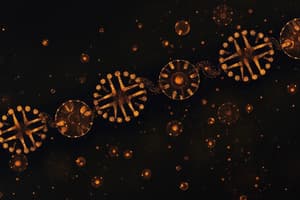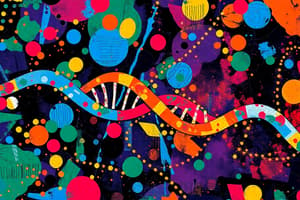Podcast
Questions and Answers
Which process is primarily involved in repairing extensive DNA damage when all replication forks are blocked?
Which process is primarily involved in repairing extensive DNA damage when all replication forks are blocked?
- Base Excision Repair
- Error prone translesion DNA synthesis (correct)
- Nucleotide Excision Repair
- Mismatch Repair
What is a characteristic feature of the bacterial DNA polymerases IV and V during the SOS response?
What is a characteristic feature of the bacterial DNA polymerases IV and V during the SOS response?
- They are part of the nucleotide excision repair pathway.
- They replicate DNA accurately without error.
- They have high fidelity and proofreading abilities.
- They lack proofreading exonuclease activity. (correct)
In which condition is the SOS response activated to facilitate DNA repair mechanisms?
In which condition is the SOS response activated to facilitate DNA repair mechanisms?
- Presence of low mutation rates
- Lack of base pair mismatches
- Significant DNA damage leading to blocked replication forks (correct)
- Normal cell cycle progression
Which of the following is true regarding the UmuD’ and UmuC complex in translesion DNA synthesis?
Which of the following is true regarding the UmuD’ and UmuC complex in translesion DNA synthesis?
In the context of hereditary non-polyposis colorectal cancer (HNPCC), which repair mechanism is most relevant to the review of DNA damage and repair?
In the context of hereditary non-polyposis colorectal cancer (HNPCC), which repair mechanism is most relevant to the review of DNA damage and repair?
What is the main genetic defect associated with Xeroderma pigmentosum?
What is the main genetic defect associated with Xeroderma pigmentosum?
Which proteins are primarily involved in the mismatch repair defects associated with HNPCC?
Which proteins are primarily involved in the mismatch repair defects associated with HNPCC?
What kind of mutations does O6-methylguanine primarily cause during DNA replication?
What kind of mutations does O6-methylguanine primarily cause during DNA replication?
Which process directly repairs pyrimidine dimers without excising nucleotides?
Which process directly repairs pyrimidine dimers without excising nucleotides?
What is the main function of the AlkB proteins in DNA repair?
What is the main function of the AlkB proteins in DNA repair?
In which wavelength range do photolyases absorb light to facilitate DNA repair?
In which wavelength range do photolyases absorb light to facilitate DNA repair?
What are the products formed during the oxidative demethylation process by AlkB?
What are the products formed during the oxidative demethylation process by AlkB?
Which condition is NOT a symptom of hereditary non-polyposis colorectal cancer (HNPCC)?
Which condition is NOT a symptom of hereditary non-polyposis colorectal cancer (HNPCC)?
Which of the following is a characteristic of Nucleotide Excision Repair?
Which of the following is a characteristic of Nucleotide Excision Repair?
What is the primary function of the enzymes MLH1 and PMS1 in eukaryotic mismatch repair?
What is the primary function of the enzymes MLH1 and PMS1 in eukaryotic mismatch repair?
Which type of DNA damage is primarily repaired by Base-Excision Repair mechanisms?
Which type of DNA damage is primarily repaired by Base-Excision Repair mechanisms?
How does the SOS response in DNA repair mainly function?
How does the SOS response in DNA repair mainly function?
Which enzyme is involved in the removal of uracil from DNA during the base-excision repair process?
Which enzyme is involved in the removal of uracil from DNA during the base-excision repair process?
What type of DNA lesions are primarily addressed by the Nucleotide Excision Repair pathway?
What type of DNA lesions are primarily addressed by the Nucleotide Excision Repair pathway?
What distinguishes hereditary non-polyposis colorectal cancer (HNPCC) in relation to mismatch repair?
What distinguishes hereditary non-polyposis colorectal cancer (HNPCC) in relation to mismatch repair?
What is the role of the UvrA, UvrB, and UvrC subunits in Nucleotide Excision Repair?
What is the role of the UvrA, UvrB, and UvrC subunits in Nucleotide Excision Repair?
Flashcards are hidden until you start studying
Study Notes
### Replication Fork Interaction with DNA Damage
- When a replication fork encounters DNA damage, repair mechanisms are activated to restore DNA integrity.
- The cell cycle is arrested to allow for repair.
- Homologous recombination is frequently employed in repairing damaged DNA, utilizing information from sister chromatids or homologous chromosomes.
### SOS Response
- The SOS response is a bacterial cellular response to DNA damage.
- It involves the activation of a set of genes, including those for DNA repair and other protective functions.
- It triggers the synthesis of DNA polymerase IV and V, which are error-prone translesion DNA synthesis (TLS) polymerases involved in bypassing damaged DNA sequences.
### Mismatch Repair
- Mismatch repair corrects errors introduced during DNA replication.
- It involves recognizing and removing mismatched bases from newly synthesized DNA strands.
- In bacteria, the system involves MutH, MutL, and MutS proteins.
- Key proteins in eukaryotic mismatch repair include MSH2, MSH3, MSH6, MLH1, and PMS1.
### Base Excision Repair
- Repairs damage caused by environmental agents.
- It involves removing damaged bases by cleaving the N-glycosyl bond between the base and the sugar of the DNA backbone.
- This creates an abasic site (AP site).
- Uracil DNA glycosylases remove uracil from DNA, which arises from cytosine deamination.
### Nucleotide Excision Repair
- Removes bulky lesions and pyrimidine dimers from DNA.
- The system involves three subunits: UvrA, UvrB, and UvrC.
- It involves two specific endonucleolytic cleavages to remove the damaged DNA segment.
### Xeroderma Pigmentosum
- A rare genetic disease characterized by sun sensitivity, increased risk of skin cancer, and neurological abnormalities.
- It results from mutations in genes involved in nucleotide excision repair, specifically XPA to XPG.
- This inability to repair pyrimidine dimers leads to the accumulation of DNA damage, increasing the risk of cancer.
### Hereditary Non-Polyposis Colorectal Cancer (HNPCC)
- An autosomal dominant inherited disease caused by defects in mismatch repair.
- Mutations in genes such as hMLH1 and hMSH2 are common in HNPCC.
- The condition increases the risk of colorectal cancer and other malignancies.
### Direct Repair
- Repair mechanism that does not involve excising or removing a base or a nucleotide.
### Photoreactivation
- A direct repair mechanism that uses light energy to reverse DNA damage.
- DNA photolyases, encoded by phr genes, recognize and bind to pyrimidine dimers.
- Upon exposure to blue light, photolyases break apart the dimer, restoring the original DNA sequence.
### Alkylation Repair
- Removes alkyl groups from DNA bases.
- Methylguanine methyltransferase (MGMT) directly removes methyl groups from O6-methylguanine, restoring the original guanine base.
- AlkB proteins can demethylate alkylated bases by oxidative decarboxylation.
- Human AlkB homologs include ALKBH1 to ALKBH8 and FTO, suggesting a role in removing various alkylated bases in humans.
Studying That Suits You
Use AI to generate personalized quizzes and flashcards to suit your learning preferences.




